Reijiro IZUMI Visits Boston, Commemorating the 60th Anniversary of the
Chado Urasenke Tankokai Boston Association
Chado Urasenke Tankokai Boston Association
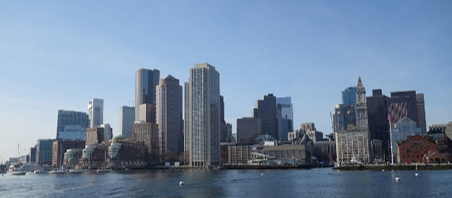 |
| image photo of the Boston skyline |
| In October 2019, following upon many months of planning, the Chado Urasenke Tankokai Boston Association successfully organized several special events commemorating their 60th anniversary. From Urasenke Headquarters, Reijiro IZUMI was present for them. Reijiro, who has earned a Ph.D. for his research about chagama (kettles for chanoyu), is a nephew of Urasenke's present iemoto, Soshitsu SEN XVI, and holds important positions within the Urasenke establishment (Board Member, Urasenke Tankokai Federation; Vice Director, Chado Research Center; Director, Konnichian Library; Vice Principal, Urasenke Gakuen Professional College of Chado). Accompanying him to Boston was Konnichian gyotei (deputy tea master) Soko SHIMURA. Approximately 150 Urasenke chado followers, including many from other Urasenke groups in North America, had registered to participate in the events. Reijiro's stay in Boston was from October 10 to 14. The day after his arrival, October 11 (Fri), he presented a lecture for the event registrants, at the Boston Public Library's historic McKim Building (founded in 1895). The lecture made use of slides, and was entitled "Chanoyu Kettles and Related Items." In it, Reijiro talked about the early development of chanoyu, and how the tea-making eventually became an act performed in the tea room, in view of the guests. At a tea gathering, the chanoyu kettle is the one article for the tea-making that is in the tea room, in view of the guests, from beginning to end, he pointed out. During the talk, he introduced many historical pictorial references and documents, to substantiate his explanations. Afterwards, he responded very kindly to the many enthusiastic questions from the audience. |
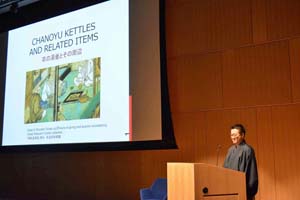 |
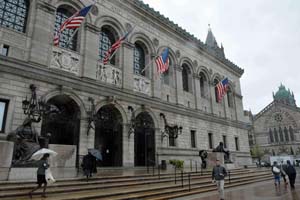 |
| Lecture on Chanoyu Kettles for the event | View of the McKim Building |
| The next day, October 12 (Sat), the Tankokai Boston Association hosted a commemorative chakai at The Westin Copley Place. It started at 9:00 A.M., and consisted in a kashi (confections to precede matcha-drinking) venue, a koicha (thick matcha, shared among guests) venue, and an usucha (relatively thin matcha, in individual servings) venue. At the waiting area, the guests could look through a collection of photos showing scenes through the history of the Tankokai Boston Association. Reijiro went around to all of the venues, and enjoyed the treats and fine arrangements that each had to offer. |
| Scenes at the Koicha Venue | |
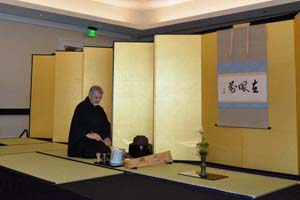 |
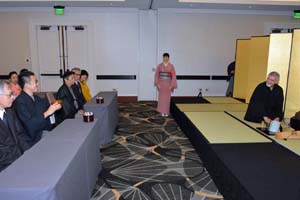 |
| Scenes at the Usucha Venue | |
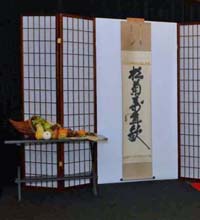 |
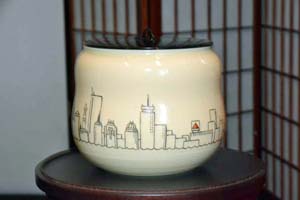 |
| A cornucopia decorates the alcove area | The specially-made Kyoto-ware ceramic water-jar with Boston skyline design |
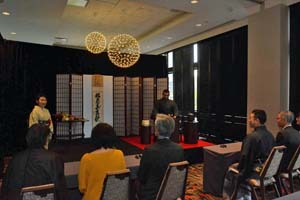 |
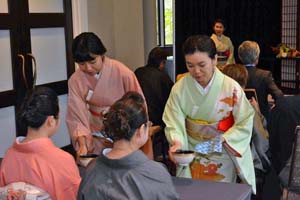 |
| The kobukusa (sewn square of fancy textile) used to carry the bowls of prepared tea were designed and order-made for the occasion. |
| A celebration banquet was held at The Westin Copley Place that evening. It began with a 60th anniversary commemoration ceremony, at which Reijiro, on behalf of the Urasenke head house, presented the Tankokai Boston Association with gifts from the head house. The association's president, Dr. David L. HOWELL (Robert K. and Dale J. Weary Professor of Japanese History, Harvard University) represented the association in receiving them. Japan's new Consul-General in Boston, Mr. Setsuo OHMORI, received a Letter of Appointment signed by the Urasenke iemoto, designating him as Honorary Advisor of the association. There were congratulatory speeches from Consul-General Ohmori and a representative of the Mayor of Boston, and then Reijiro, representing the Urasenke head house, presented commendation certificates to persons who have devoted themselves for a great many years to spreading and developing Urasenke chado in the Boston area. The commemorative ceremony closed with a congratulatory toast offered by the director of the Art Complex Museum in Duxbury, Charles WEYERHAEUSER, and everyone's raising of their glasses to this toast. Throughout the meal that followed, the attendees enjoyed socializing and deepening their friendships. When it was about ending time, the association's Chief of Administration, Glenn Sorei PEREIRA, stepped forward to the microphone, and expressed his thanks to all the attendees. He said that his dream for the association to hold such an anniversary celebration blessed by such friends and supporters of the association as were gathered there that evening had been one he had worked toward for many years, and that he was thrilled that Reijiro could be in attendance from the Urasenke head family. He also explained that he was determined to help further spread Chado in the USA. |
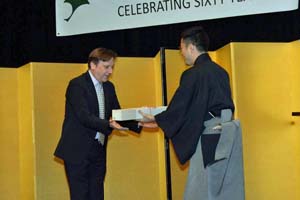 |
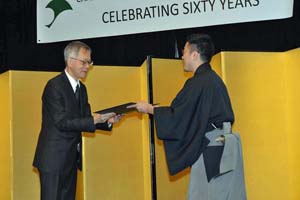 |
| Association President David L HOWELL accepts gifts to the Association |
Consul-General Setsuo OHMORI receives appointment certificate as Honorary Advisor to the Association |
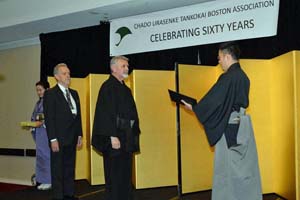 |
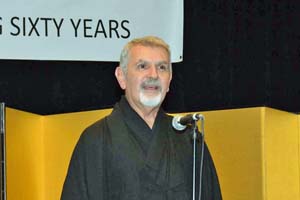 |
| Commendation certificate presentation ceremony |
Association Chief of Administration Glenn Sorei PEREIRA presents the closing thank-you speech |
| The following day, October 13 (Sun), was the final day of Reijiro's official schedule in Boston. The main event was his lecture and chado demonstration at Harvard University. For this program, which was open to the public, the Harvard-Radcliff Chado Society took charge of the reception. Reijiro first of all visited the Harvard tea room, where the Society welcomed him as their guest for a simple chakai (tea get-together). |
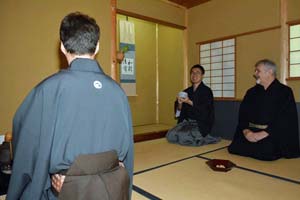 |
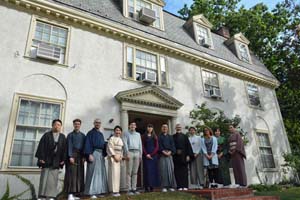 |
| Chakai in the Harvard tea room | Commemorative photo with members and teachers of the Harvard-Radcliff Chado Society |
| The President of the Tankokai Boston Association, Dr. Howell, currently serves as Chair of the Department of East Asian Languages & Civilizations at Harvard University. Reijiro paid a visit to Dr. Howell's office, and prepared matcha bonryaku style (style using equipment arranged on a tray) for him. |
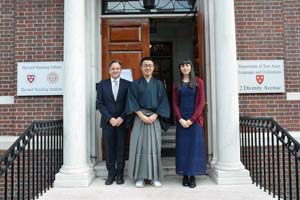 |
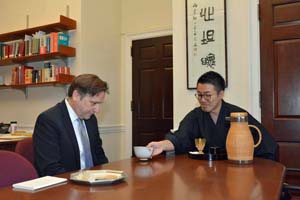 |
| The public lecture and chado demonstration program, entitled "The Tea Culture of Japan," was co-sponsored by the Tankokai Boston Association and the Consulate General of Japan in Boston, and drew an audience of approximately two hundred people. It began at 1:00 P.M., with both Dr. Howell and Consul-General Ohmori presenting welcoming addresses, as representatives of the program's sponsors. Reijiro's talk was accompanied by slides. He began by explaining about the different facets of a tea function, and went on to described the circumstances leading to the rise of the wabicha chado tradition in Japan, and how that tradition has developed. Through the chado demonstration which followed, for which he provided the explanations, the audience could get a glimpse of how the host and guests interact in chado. Dr. Howell lastly provided closing comments. When the program ended, Reijiro was thanked with enthusiastic applause from the audience as he departed from the stage. |
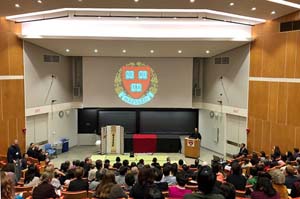 |
| Reijiro gives talk on Japanese tea culture |
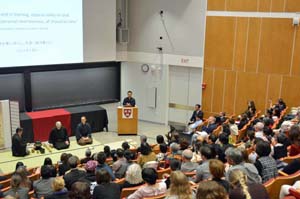 |
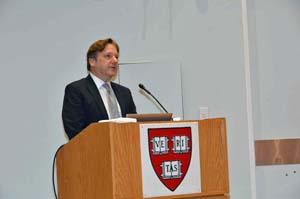 |
| Chado demonstration | Dr. Howell gives closing comments |
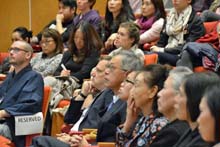 |
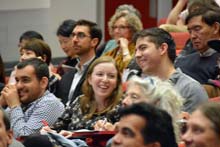 |
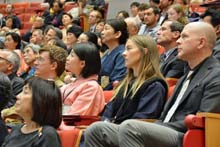 |
| HOME |